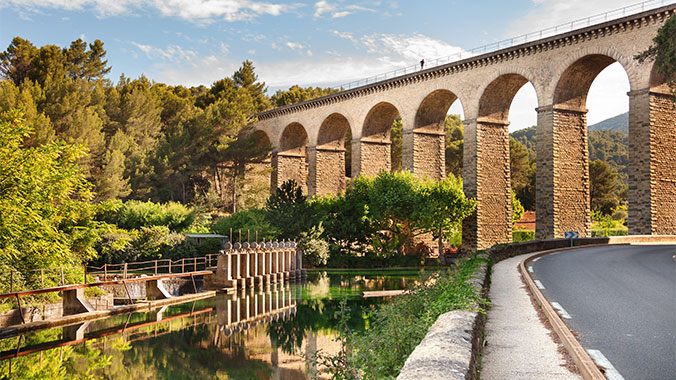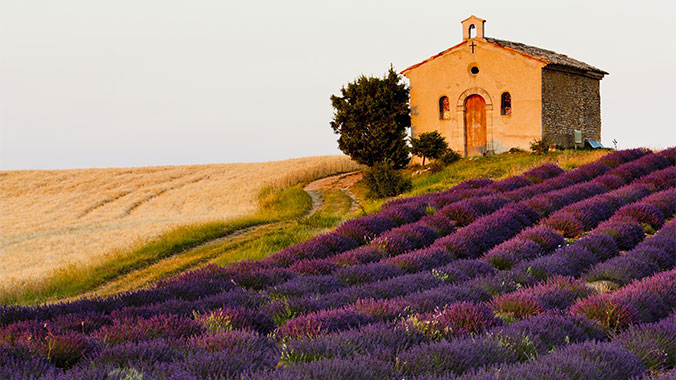Online Program
Adventures Online: A Journey Through the Many Faces of Provence
Program No. 24177RJ
Immerse yourself in the art and history of Provence from the comfort of your own home as local experts share their knowledge during online field trips and online presentations.
Itinerary
While we make every effort to ensure the accuracy of our published materials, programs are typically advertised more than a year prior to their start date.
Day
1
Provence & the Art of Living, Culture, Cuisine
Location:
From the comfort of your own home.
Orientation
Orientation and Introductions
As we meet our staff, we will have a brief overview on how to use Zoom, the program’s topic, guidelines, and the daily schedule.
Session 1
Provence, A Treat for All Senses
(Lecture)
Caroline and Martin will present Provence as a treat for all the senses, focusing on Provençal culture and art de vivre — the art of living.
Break
Break
Take some time to stretch, relax, and prepare for our next lesson.
Session 2
From Aix to the Back Country: Discover the Many Charms of Provence
(Field Trip)
Gain an appreciation for some of the many charms of Provence such as wines and cuisine, local markets, lavender, typical crafts, architecture, the Camargue, and distinctive sites including Lacoste, Bonnieux, Lourmarin, Gordes, Roussillon, and Apt.
Provençal Literature
(Interview / Panel Discussion)
A Q&A and discussion session focusing on Provençal literature.
Wrap-up
Daily Wrap-up
We will end with a review of the topics we have discussed today and a preview of what’s ahead for tomorrow.
End of Day
Today's session will end.
Day
2
Provence Roman Heritage, Orange, Nîmes, Arles, Pont du Gard
Location:
From the comfort of your own home.
Session 1
Welcome
Greet everyone and review the day's schedule.
Roman Heritage in Provence
(Lecture)
Caroline and Martin will address the Roman heritage. Is Provence a Roman invention? Learn about the Romans in Gaul and the Gallic Wars.
Break
Break
Take some time to stretch, relax, and prepare for our next lesson.
Session 2
The Gallo Roman Wonders of Southern France
(Field Trip)
Explore the Gallo Roman wonders of southern France. Highlights will include the ancient Roman theatre of Orange, the best preserved in Europe and a UNESCO-designated World Heritage Site; and Nîmes with its wonderfully well preserved Roman Arena/Amphitheatre still in use today and the exceptional Maison Carrée (Square House) temple. From Arles, we will see Roman monuments including the Amphitheatre, built not long after the Colosseum in Rome and far better preserved; the Baths of Constantine; the “cryptoportiques” that formed the base of the ancient Forum, constructed in the first century BCE; and the Alyscamps necropolis outside the old city walls. We will be able to appreciate the genius of Roman architects in the Pont Du Gard, also dating from the end of the first century BCE and considered a magnificent work of art. More than 31 miles (50 km) long, it carried water to the Roman colony of Nemausus, now known as Nîmes.
The Roman Legacy
(Interview / Panel Discussion)
A Q&A and discussion session focusing on The Roman Legacy today.
Wrap-up
Daily Wrap-up
We will end with a review of the topics we have discussed today and a preview of what’s ahead for tomorrow.
End of Day
Today's session will end.
Day
3
Medieval Provence, Abbeys, Cathedrals, Crusades, Popes
Location:
From the comfort of your own home.
Session 1
Welcome
Greet everyone and review the day's schedule.
The Age of Abbeys & Cathedrals
(Lecture)
Provence in the era of medieval abbeys and cathedrals.
Break
Break
Take some time to stretch, relax, and prepare for our next lesson.
Session 2
Medieval Abbeys and Cathedrals
(Field Trip)
Explore Provence's Medieval Abbeys and Cathedrals. The abbey of Notre-Dame de Sénanque was founded in 1148. Today, it is the home of monks who cultivate lavender, olive trees, honey, and provide hospitality. We will then explore the Cathédrale Saint-Trophime and its cloister in Arles dating from the late 11th century, part of UNESCO’s designation of Arles’ Roman and Romanseque monuments as a World Heritage Site. Tradition says the Cathédrale Saint-Sauveur in Aix-en-Provence was built on what had been a pagan sacred site and replaced by a temple to Apollo. Its construction stretched over seven centuries with styles encompassing Roman, Romanesque, Gothic, and Baroque. Our virtual field trip will continue to the walled city of Aigues-Morte in the Camargue. It was the starting point for the Seventh Crusade led by King Louis IX, later Saint Louis, in 1248. Aigues-Morte became an important center of salt mining and its massive ramparts remain in place. The so-called “Babylonian Captivity” took place in the 14th century when King Philip IV of France succeeded in moving the Holy See to Avignon. We will see the amazing Palais des Papes — Palace of the Popes. We will see beautiful Les Baux de Provence and Tarascon. Archaeologists estimate that human settlement here began around 6000 BCE. Different monarchs fought for control over the centuries. Fortified Les Baux was eventually brought into the Kingdom of France. Tarascon on the Rhône River has an equally complicated history as well as crenelated walls.
Provence Legacy
(Interview / Panel Discussion)
A Q&A and discussion session focusing on the question, Is Provence a land of myths and legends?
Wrap-up
Daily Wrap-up
We will end with a review of the topics we have discussed today and a preview of what’s ahead for tomorrow.
End of Day
Today's session will end.
Day
4
Art & Painters in Provence
Location:
From the comfort of your own home.
Session 1
Welcome
Greet everyone and review the day's schedule.
Painting Provence: A World of Light and Colors
(Lecture)
A lecture on painting in Provence, a world of light and colors. Its extraordinary natural beauty, varied landscapes, characteristic villages, architecture, and fascinating people have attracted artists since the 15th century.
Break
Break
Take some time to stretch, relax, and prepare for our next lesson.
Session 2
In the Footsteps of the Painters in Provence
(Field Trip)
Our virtual field trip will take us in the footsteps of some of the most notable painters who have created great art such as Cézanne in Aix en Provence and Van Gogh in Arles, as well as those who favored the French Riviera including Chagall, Matisse, Picasso, Duffy, Braque, Monet, and Renoir.
Provence Art in the 20th Century
(Interview / Panel Discussion)
A Q&A and discussion session focusing on the turn of the 20th century: an artistic revolution.
Wrap-up
Program Wrap-up
We will recap what we’ve learned over the past few days and say farewell. This concludes our program. We hope you enjoy Road Scholar learning adventures and look forward to having you on rewarding programs in the future. Don’t forget to like our Facebook page and follow us on Instagram. Best wishes for all your journeys!
Program Conclusion
This concludes our program.




